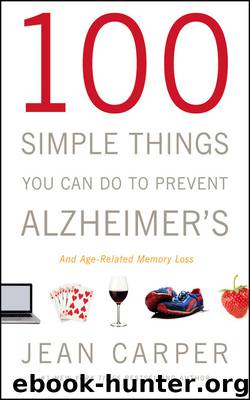100 Simple Things You Can Do to Prevent Alzheimer's and Age-Related Memory Loss by Jean Carper

Author:Jean Carper [CARPER, JEAN]
Language: eng
Format: epub
Tags: HEA039140
ISBN: 9780316121606
Publisher: Little, Brown and Company
Published: 2010-09-19T16:00:00+00:00
50
TRY TO KEEP INFECTIONS AWAY
Pathogens in the brain may be an underlying cause of Alzheimer’s
Is it possible that infections could trigger Alzheimer’s? Some scientists believe so. The idea is very controversial and gaining renewed attention. Recently, the Journal of Alzheimer’s Disease devoted a special issue to emerging evidence linking Alzheimer’s to common microorganisms that cause cold sores, gastric ulcers, Lyme disease, pneumonia, and even the flu.
Scientists know that infectious agents hang out in Alzheimer’s brains. Leading researcher Brian Balin, PhD, at the Philadelphia College of Osteopathic Medicine, discovered Chlamydia pneumoniae bacteria in 90 percent of brain samples from deceased Alzheimer’s patients, compared to only 5 percent of samples from normal brains. The implications are enormous, since this pathogen is one cause of community-acquired pneumonia, a common infection, especially in people over age sixty-five.
Remarkably, after Balin let normal non-Alzheimer’s-prone mice sniff the C. pneumoniae bacteria, their brains also developed toxic amyloid deposits—rare even in such aged mice. This proves, he says, that the infectious agent can initiate Alzheimer’s pathology, causing the disease.
Herpes simplex virus type 1 (a cause of cold sores) is also a prime suspect. The DNA of the virus is three times more apt to show up in the plaques of Alzheimer’s brains than in normal brains, says Ruth Itzhaki, PhD, at the University of Manchester in England. She calls the virus “a major cause of amyloid plaques” and estimates that the cold sore virus could cause about 60 percent of all Alzheimer’s cases.
Another potential culprit: Helicobacter pylori bacteria, which cause gastric and peptic ulcers. In a Greek study, Alzheimer’s patients were nearly twice as likely to have H. pylori infections as normal patients.
There’s also evidence that a common influenza virus may settle in your brain, leading to neurodegenerative damage. And Canadian research has found the Lyme disease infection spirochete (Borrelia burgdorferi) residing in Alzheimer’s brain tissue alongside amyloid plaques.
Here’s the theory, explains Balin: Various microbes, inhaled or taken into the blood, enter the brain, causing an infection that becomes chronic, perhaps lingering for years undetected. The infection triggers toxic beta-amyloid production and encourages neuronal destruction precisely in the areas of the brain governing memory and cognition. Thus the infection is the underlying cause of the plaque that triggers Alzheimer’s.
Especially unsettling: some pathogens, such as C. pneumoniae, may float in the communal air and be quickly inhaled directly into the brain. That raises this intriguing question: if Alzheimer’s is airborne, might it even be contagious? “Possibly,” says Balin, although he points out that many other factors would influence whether it actually ends up as Alzheimer’s.
There is growing evidence that beta-amyloid brain buildup is tied to infection. As we age, low-grade infections may trigger the immune system to produce beta-amyloid as a kind of “antibiotic” to defend brain cells, says Rudolph Tanzi, PhD, at Massachusetts General Hospital’s Institute for Neurodegenerative Disease. Indeed, Tanzi has demonstrated that beta-amyloid inhibits the growth of eight organisms, including Candida albicans, listeria, staphylococcus, and streptococcus. The theory: a little beta-amyloid initially may be protective, but lots of it over a long period goes awry and becomes lethal to brain cells.
Download
This site does not store any files on its server. We only index and link to content provided by other sites. Please contact the content providers to delete copyright contents if any and email us, we'll remove relevant links or contents immediately.
Periodization Training for Sports by Tudor Bompa(8171)
Why We Sleep: Unlocking the Power of Sleep and Dreams by Matthew Walker(6618)
Paper Towns by Green John(5092)
The Immortal Life of Henrietta Lacks by Rebecca Skloot(4526)
The Sports Rules Book by Human Kinetics(4296)
Dynamic Alignment Through Imagery by Eric Franklin(4118)
ACSM's Complete Guide to Fitness & Health by ACSM(3989)
Kaplan MCAT Organic Chemistry Review: Created for MCAT 2015 (Kaplan Test Prep) by Kaplan(3940)
Introduction to Kinesiology by Shirl J. Hoffman(3726)
Livewired by David Eagleman(3685)
The Death of the Heart by Elizabeth Bowen(3553)
The River of Consciousness by Oliver Sacks(3542)
Alchemy and Alchemists by C. J. S. Thompson(3451)
Bad Pharma by Ben Goldacre(3357)
Descartes' Error by Antonio Damasio(3231)
The Emperor of All Maladies: A Biography of Cancer by Siddhartha Mukherjee(3068)
The Gene: An Intimate History by Siddhartha Mukherjee(3049)
The Fate of Rome: Climate, Disease, and the End of an Empire (The Princeton History of the Ancient World) by Kyle Harper(3006)
Kaplan MCAT Behavioral Sciences Review: Created for MCAT 2015 (Kaplan Test Prep) by Kaplan(2941)
